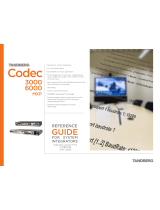
D15334.08 Cisco TelePresence MX200 G2 and MX300 G2 API Reference Guide CE9.2, NOVEMBER 2017. Copyright © 2017 Cisco Systems, Inc. All rights reserved. 19
Cisco TelePresence MX200 G2 and MX300 G2 API Reference Guide
System status changes in CE9.0
New statuses
Video Output Connector [n] ConnectedDevice CEC [n] Name
Video Output Connector [n] ConnectedDevice CEC [n] VendorId
Statuses that are modified
Diagnostics Message [n] Type
OLD: CAPFOperationState, CTLinstallation, CUCMVendorConfigurationFile,
CallProtocolDualStackConfig, CallProtocolIPStackPlatformCompatibility, CallProtocolVcsPr
ovisioningCompatibility, CameraId, CameraPairing, CameraSerial, CameraSoftwareVersion,
CameraStatus, CamerasDetected, ConfigurationFile, DefaultCallProtocolRegistered,
EthernetDuplexMatches, FanStatus, PresenterTrack, H320GatewayStatus,
H323GatekeeperStatus, HasValidReleaseKey, IpCameraStatus, IPv4Assignment,
IPv6Assignment, IPv6Mtu, ISDNLinkCompatibility, ISDNLinkIpStack, ITLinstallation,
InvalidSIPTransportConfig, LockDown, RoomControl, MediaBlockingDetected,
NetLinkStatus, NetSpeedAutoNegotiated, NetworkQuality, NTPStatus,
OSDVideoOutput, OutputConnectorLocations, ProvisioningStatus, SIPEncryption,
SIPListenPortAndOutboundMode, SIPProfileRegistration, SIPProfileType, SelectedVideo
InputSourceConnected, SipIceAndAnatConflict, TCPMediaFallback, TemperatureCheck,
TLSVerifyRequiredCerts, TouchPanelConnection, ControlSystemConnection,
TurnBandwidth, UdpPortRangeViolation, UltrasoundSpeakerAvailability, ValidPasswords,
VideoFromInternalCamera, VideoInputStability, SparkConnectivity, SpeakerTrackFrontP
anelMountedCorrectly, SpeakerTrackMicrophoneConnection, SpeakerTrackVideoInputs,
SpeakerTrackEthernetConnection, ANATOnVCS, ECReferenceDelay, AudioECRefDelay,
AudioPairingNoise, AudioPairingRate, AudioPairingSNR, AudioPairingInterference,
AudioPairingTokenDecode, AudioInternalSpeakerDisabled, AbnormalCallTermination,
HasActiveCallProtocol, SipOrH323ButNotBothEnabled, PresentationSourceSelection,
SoftwareUpgrade, PlatformSanity, ContactInfoMismatch, MicrophoneReinforcement
NEW: CAPFOperationState, CTLinstallation, CUCMVendorConfigurationFile,
CallProtocolDualStackConfig, CallProtocolIPStackPlatformCompatibility, CallP
rotocolVcsProvisioningCompatibility, CameraId, CameraPairing, CameraSerial,
CameraSoftwareVersion, CameraStatus, CamerasDetected, ConfigurationFile,
DefaultCallProtocolRegistered, EthernetDuplexMatches, FanStatus, PresenterTrack,
H320GatewayStatus, H323GatekeeperStatus, HasValidReleaseKey, IpCameraStatus,
IPv4Assignment, IPv6Assignment, IPv6Mtu, ISDNLinkCompatibility, ISDNLinkIpStack,
ITLinstallation, InvalidSIPTransportConfig, LockDown, RoomControl,
MediaBlockingDetected, NetLinkStatus, NetSpeedAutoNegotiated, NetworkQuality,
NTPStatus, OSDVideoOutput, OutputConnectorLocations, ProvisioningDeveloperOptions,
ProvisioningStatus, SIPEncryption, SIPListenPortAndOutboundMode,
SIPProfileRegistration, SIPProfileType, SelectedVideoInputSourceConnec
ted, SipIceAndAnatConflict, SIPListenPortAndRegistration, TCPMediaFallback,
TemperatureCheck, TLSVerifyRequiredCerts, TouchPanelConnection,
ControlSystemConnection, TurnBandwidth, UdpPortRangeViolation,
UltrasoundSpeakerAvailability, ValidPasswords, VideoFromInternalCamera,
VideoInputStability, VideoInputSignalQuality, SparkConnectivity, SpeakerTrackFrontPa
nelMountedCorrectly, SpeakerTrackMicrophoneConnection, SpeakerTrackVideoInputs,
SpeakerTrackEthernetConnection, ANATOnVCS, ECReferenceDelay, AudioECRefDelay,
AudioPairingNoise, AudioPairingRate, AudioPairingSNR, AudioPairingInterference,
AudioPairingTokenDecode, AudioInternalSpeakerDisabled, AbnormalCallTermination,
HasActiveCallProtocol, SipOrH323ButNotBothEnabled, PresentationSourceSelection,
SoftwareUpgrade, PlatformSanity, ContactInfoMismatch, MicrophoneReinforcement,
FirstTimeWizardNotCompleted, CaptivePortalDetected, MonitorDelay
xStatus with INTEGRATOR user role
Audio Input Connectors Microphone[n] ConnectionStatus
Audio Microphones Mute
Audio Output Connectors Line[n] DelayMs
Audio Volume
Call[n] FacilityServiceId
Call[n] ReceiveCallRate
Call[n] TransmitCallRateCameras Camera[n] Capabilities Options
Cameras Camera[n] ConnectedCameras Camera[n] HardwareID
Cameras Camera[n] MacAddress
Cameras Camera[n] Manufacturer
Cameras Camera[n] Model
Cameras Camera[n] Position Focus
Cameras Camera[n] Position Pan
Cameras Camera[n] Position Tilt
Cameras Camera[n] Position Zoom
Cameras Camera[n] SoftwareID
Conference DoNotDisturb
Conference Presentation CallId
Conference Presentation LocalInstance[n] SendingMode
























